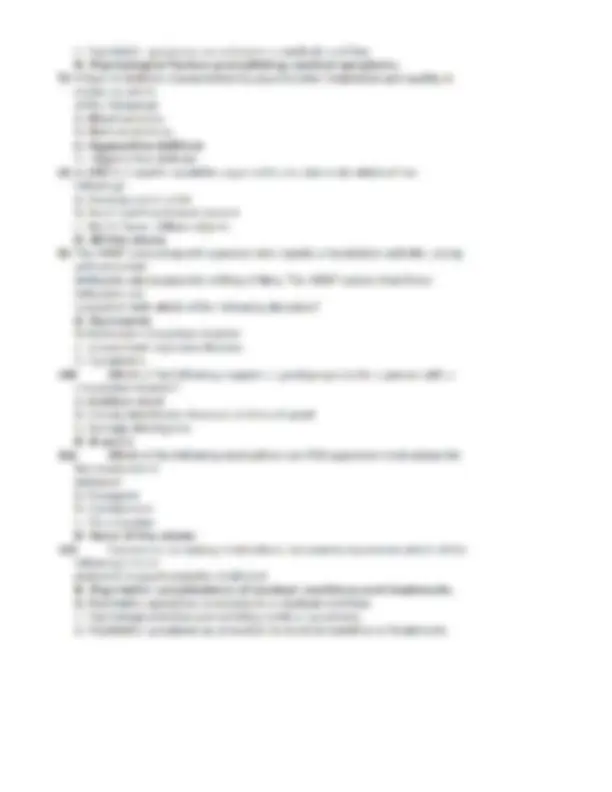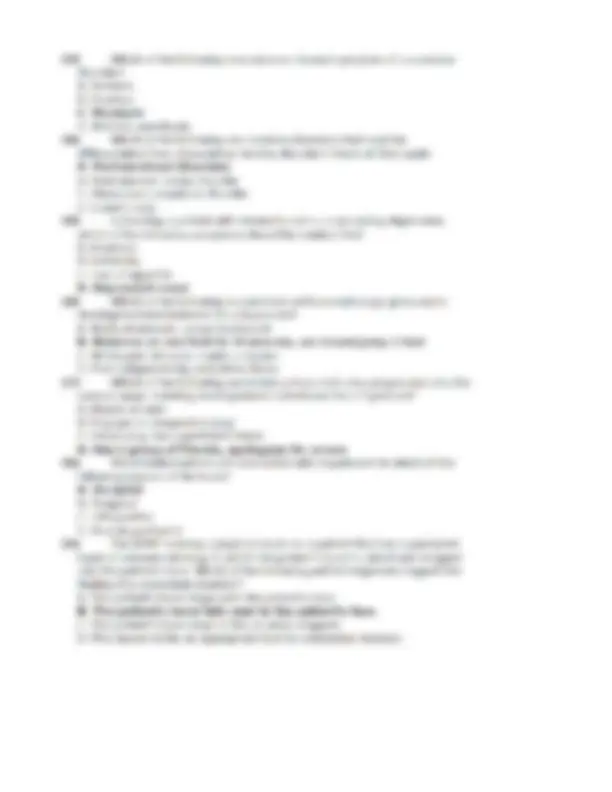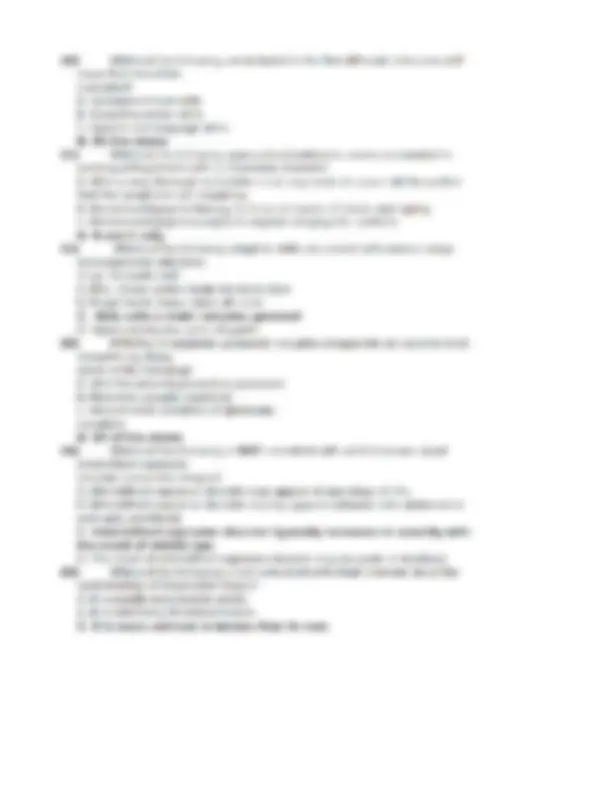Partial preview of the text
Download NRNP 6665 Final Exam (Version-3, 100 Q & A, Latest-2025) / NRNP6665 Final Exam: Walden Uni and more Exams Nursing in PDF only on Docsity!
1) Which of the following would be a developmental red flag that would trigger further assessment for a 2-year-old? A. Cannot jump; cannot throw object overhand. B. Cannot use a three-word sentence; speech only 50% understandable c. Cannot use a meaningful two-word phrase; lack of empathy (looking sad if a child cries) D. Never imitates adult activities; cannot do parallel play. 2) Which of the following are included in the clinical features of anxiety illness disorder? Check all that apply. A. Persons maintain they have a particular disease or as time progresses their belief may transfer to another disease. B. Lab results, lack of progression of the disease, and appropriate reassurances from the provider are helpful treatments for the person with the disease. C. Preoccupation with illness may or may not interfere with their interaction family, friends, and co-workers. D. They are often addicted to internet search about their feared illness, inferring the worst from the information. 3) A dementia which usually occurs in the sixth decade of life, characterized by gradual onset and progressive decline without focal neurological deficits is known as which of the following? A. HIV dementia B. Vascular dementia C. Lewy-body dementia D. Alzheimer's type dementia (DAT) 4) Which of the following is true about impulses? Check all that apply. A. Impulses are acted upon with the expectation of receiving pleasure B. Impulses are usually egodystonic. C. Impulsive behaviors are characterized by their repetitive nature. D. The repeated acting out of impulses leads to psychological impairment. 5) Which of the following is consistent with dementia in HIV? A. The individual's decline is very slow and may take years to progress. B. The individual's decline is progressive in nature with motoric and behavioral abnormalities. C. The individual's decline is in a stepwise fashion with motoric and behavioral abnormalities. D. The individual's decline has marked variability and fluctuating motoric and behavioral abnormalities. 6) Somatoform disorders represent which type of clinical problem in psychosomatic Medicine? A. Co-occurring medical and psychiatric conditions. B. Psychiatric complications of medical conditions and treatments. 13) Which of the following is a common visceral symptom of conversion disorder? A. Seizures B. Diarrhea C. Paralysis D. Mid-line anesthesia 14) Which of the following are common disorders that must be differentiated from dissociative identity disorder? Check all that apply. A. Perimenstrual disorders B. Posttraumatic stress disorder C. Obsessive-compulsive disorder D. B and C only 15) In treating a patient with dementia and a co-occurring depression, which of the following symptoms should be treated first? A. Insomnia B. Irritability C. Loss of appetite D. Depressed mood 16) Which of the following is consistent with normal range gross motor developmental milestones for a 4-year-old? A. Walks downstairs, jumps backwards B. Balances on one foot for 4 seconds, can broad jump 1 foot C. Writes part of name; copies a square. D, Eats independently, unbuttons items 17) Which of the following social interactions indicates progression into the normal range, meeting developmental milestones for a 5-year-old? A. Shares on own B. Engages in imaginative play C. Group play; has a preferred friend D. Has a group of friends, apologizes for errors 18) Visual hallucinations are associated with impairment in which of the following regions of the brain? A. Occipital B. Temporal C. Left parietal D. Frontal, prefrontal 19) The ARNP is doing a physical exam on a patient that has a paralyzed hand of unknown etiology in which the patient's hand is raised and dropped into the patient's face. Which of the following patient responses support the finding of a conversion disorder? A. The patient's hand drops onto the patient's face. B. The patient's hand falls next to the patient's face. C. The patient's hand stays in the air when dropped. D. This would not be an appropriate test for conversion disorder. 20) Which of the following are included in the five different milestone skill areas that should be evaluated? A. Social/emotional skills B. Gross/fine motor skills C. Speech and language skills D. All the above 21) Which of the following approaches/treatments are recommended in working with patients with a conversion disorder? A. After a very thorough evaluation to r/o any medical cause, tell the patient that the symptoms are imaginary. B. Recommend psychotherapy to focus on issues of stress and coping. C. Recommend psychoanalysis to explore intrapsychic conflicts. D. B and C only 22) Which of the following adaptive skills are consist with normal range developmental milestone of an 18-month-old? A. Bite, chews cookie; looks for fallen item B. Finger feeds items; takes off a hat. C. Gets onto a chair; removes garment D. Opens doorknobs; pulls off pants. 23) N-Methyl D-aspartate glutamate receptor antagonists are used to treat dementia by doing which of the following? A. Stall the neurodegenerative processes B. Promotes synaptic plasticity C. Prevent over excitation of glutamate receptors D. All of the above 24) Which of the following is NOT consistent with what is known about intermittent explosive disorder across the lifespan? A. Intermittent explosive disorder may appear at any stage of life. B. Intermittent explosive disorder usually appears between late adolescence and early adulthood. C. Intermittent explosive disorder typically increases in severity with the onset of middle age. D. The onset of intermittent explosive disorder may be acute or insidious. 25) Which of the following is not consistent with what is known about the epidemiology of dissociative fugue? A. It is usually described in adults. B. It is commonly described in men C. It is more common in women than in men. B. Prefrontal cortex C. Temporal lobe D. Parietal lobe 33) The ARNP evaluates a 4-year-old who cannot balance on one foot for 3 seconds, cannot copy a circle and realizes which of the following? A. This is normal for a 4-year-old. B. This is a developmental red flag for a 4-year-old that should trigger a specialized assessment. C. This is a developmental red flag for a 5-year-old so do nothing at this point. D. This is a minor concern, the APRN advises to enroll the child in gymnastics for balance and an art class to learn to draw better. 34) Which of the following is consistent with what is known about treating individuals with kleptomania? A. Insight-oriented psychotherapy has been shown to be effective regardless of motivation level of the individual. B. Psychoanalysis is the treatment of choice. C. Behavior therapy including aversion therapy has been reported to be successful with highly motivated individuals. D. A combination of aversive conditioning and alter social contingencies has been reported successful even when self-motivation was lacking 













